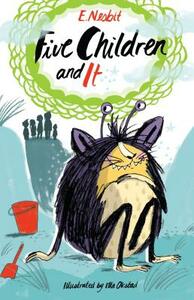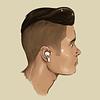You need to sign in or sign up before continuing.
Take a photo of a barcode or cover
I never read this book as a child so had to read it as an adult and I am pleased I did, it is a lovely little book. The book follows four children who find a sand fairy or Psammead who can grant them one wish a day. Obviously the children are thrilled about this and every chapter details a new wish and inevitably how it doesn't go to plan. Its a very well written book and although its over 100 years old it holds up well. The chapter 'Scalps' is rather politically incorrect today but fitting of the time the book was written. If you haven't read it, its a children's classic for a reason and its a quick read!
adventurous
funny
lighthearted
fast-paced
Plot or Character Driven:
Plot
Strong character development:
No
Loveable characters:
Yes
Diverse cast of characters:
No
Flaws of characters a main focus:
No
Cute, classic, magical story for children. Full of morals and lessons learned.
Fairly repetitive and the children are too selfish and precocious to be endearing.
4.5 stars.
Edith Nesbit is one of my all time favorite children’s authors and I only give her four stars here in comparison to others of her own works. If I were rating this book against other children’s authors, it would still only stand just a little below The Wind In The Willows, The Hobbit, The Secret Garden, Winnie The Pooh, and Narnia. But compared to The Railway Children or The Enchanted Castle, it is an obviously lesser work.
In The Five Children And It, the four eldest siblings of a family who has recently moved to the countryside accidentally unearth a sand fairy who grants them one collective wish every day. As in so many other similar tales from every imaginable genre, each gift they wish for is poorly worded or accidentally misinterpreted, so that they spend most of their time trying to survive and solve the problems they have brought down on their own heads, often with courageous and hilarious results.
Like most Nesbit, this book has a glorious way with words. She legitimizes the humanity of her child heroes through their complex reasoning skills and dialogues. Her dialogue is an obvious source of inspiration for many authors who followed her, C.S. Lewis being chief among them. She also legitimizes childlike wonder and relatability of children for adults through her whimsical narrator’s interjections. Throughout this book and as well as she ever did, Nesbit sets a tone that weaves adult behavior into children’s perspective and child-likeness into adult perceptions.
The thing I didn’t prefer about this novel was the somewhat offhanded episodic nature of the story. The tales are interwoven well enough, but they feel like rough sketch’s of “what-if’s” scenarios, not always thought out very deeply. The episodic nature of The Railway Children seems to build and build upon itself in a glorious way, creating depth of character and story for the family of that book. In The Five Children And It, some of the episodes feel half-baked even as they are happening to the children. The magical enchantments seem inconsistent in nature and almost tailored to fit the solutions the kids come up with. By the end, it felt like I was reading a sketch book with outlines for ideas rather than a finished product.
Good reading, worth your time, at or above par in the swelling crowds of children’s classics, but doesn’t sing with the quality I have grown to expect from Nesbit.
Edith Nesbit is one of my all time favorite children’s authors and I only give her four stars here in comparison to others of her own works. If I were rating this book against other children’s authors, it would still only stand just a little below The Wind In The Willows, The Hobbit, The Secret Garden, Winnie The Pooh, and Narnia. But compared to The Railway Children or The Enchanted Castle, it is an obviously lesser work.
In The Five Children And It, the four eldest siblings of a family who has recently moved to the countryside accidentally unearth a sand fairy who grants them one collective wish every day. As in so many other similar tales from every imaginable genre, each gift they wish for is poorly worded or accidentally misinterpreted, so that they spend most of their time trying to survive and solve the problems they have brought down on their own heads, often with courageous and hilarious results.
Like most Nesbit, this book has a glorious way with words. She legitimizes the humanity of her child heroes through their complex reasoning skills and dialogues. Her dialogue is an obvious source of inspiration for many authors who followed her, C.S. Lewis being chief among them. She also legitimizes childlike wonder and relatability of children for adults through her whimsical narrator’s interjections. Throughout this book and as well as she ever did, Nesbit sets a tone that weaves adult behavior into children’s perspective and child-likeness into adult perceptions.
The thing I didn’t prefer about this novel was the somewhat offhanded episodic nature of the story. The tales are interwoven well enough, but they feel like rough sketch’s of “what-if’s” scenarios, not always thought out very deeply. The episodic nature of The Railway Children seems to build and build upon itself in a glorious way, creating depth of character and story for the family of that book. In The Five Children And It, some of the episodes feel half-baked even as they are happening to the children. The magical enchantments seem inconsistent in nature and almost tailored to fit the solutions the kids come up with. By the end, it felt like I was reading a sketch book with outlines for ideas rather than a finished product.
Good reading, worth your time, at or above par in the swelling crowds of children’s classics, but doesn’t sing with the quality I have grown to expect from Nesbit.
This was a delightful little story that my 8 year old loved. It was written in 1902, so it's not the easiest book to read aloud because of the more antiquated patterns of speech. And there were two points in which I was uncomfortable with how these white, English children spoke about Native American and African people, but such was also the convention of the time. So just be prepared to put down the book for a second and explain to your kid why we don't talk about Native Americans as caricatures (whooping 'war Indians') and the African continent does not exist solely as an object of conquest and exploitation.
Other than that, we enjoyed this book greatly and reserved the sequel at the library.
Other than that, we enjoyed this book greatly and reserved the sequel at the library.
(Year of Epic Reads Weekly Challenge #21: Read a book that spotlights siblings.)
adventurous
funny
medium-paced
Plot or Character Driven:
A mix
Strong character development:
Yes
Loveable characters:
Yes
Diverse cast of characters:
No
Flaws of characters a main focus:
No
This book is hilarious. Be careful what you wish for, indeed. Except for the unfortunate chapter with ‘red Indians’, I would say it holds up very well.
RATL24 - 1900s (1902)
RATL24 - 1900s (1902)





